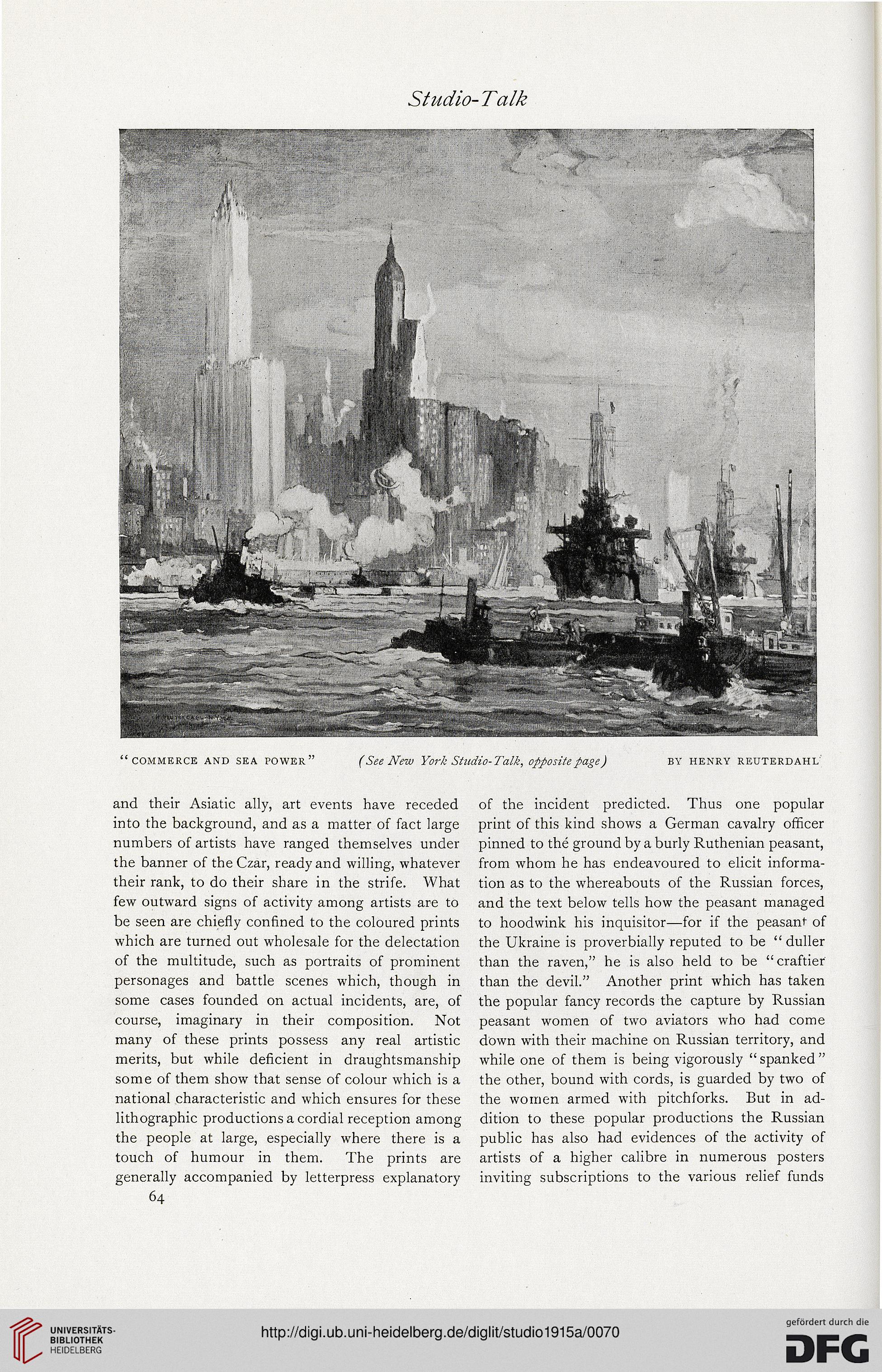Studio-Talk
“commerce and sea power” (See New York Studio-Talk, opposite page) by henry reuterdahi.
and their Asiatic ally, art events have receded
into the background, and as a matter of fact large
numbers of artists have ranged themselves under
the banner of the Czar, ready and willing, whatever
their rank, to do their share in the strife. What
few outward signs of activity among artists are to
be seen are chiefly confined to the coloured prints
which are turned out wholesale for the delectation
of the multitude, such as portraits of prominent
personages and battle scenes which, though in
some cases founded on actual incidents, are, of
course, imaginary in their composition. Not
many of these prints possess any real artistic
merits, but while deficient in draughtsmanship
some of them show that sense of colour which is a
national characteristic and which ensures for these
lithographic productions a cordial reception among
the people at large, especially where there is a
touch of humour in them. The prints are
generally accompanied by letterpress explanatory
64
of the incident predicted. Thus one popular
print of this kind shows a German cavalry officer
pinned to the ground by a burly Ruthenian peasant,
from whom he has endeavoured to elicit informa-
tion as to the whereabouts of the Russian forces,
and the text below tells how the peasant managed
to hoodwink his inquisitor—for if the peasant of
the Ukraine is proverbially reputed to be “duller
than the raven,” he is also held to be “ craftier
than the devil.” Another print which has taken
the popular fancy records the capture by Russian
peasant women of two aviators who had come
down with their machine on Russian territory, and
while one of them is being vigorously “ spanked ”
the other, bound with cords, is guarded by two of
the women armed with pitchforks. But in ad-
dition to these popular productions the Russian
public has also had evidences of the activity of
artists of a higher calibre in numerous posters
inviting subscriptions to the various relief funds
“commerce and sea power” (See New York Studio-Talk, opposite page) by henry reuterdahi.
and their Asiatic ally, art events have receded
into the background, and as a matter of fact large
numbers of artists have ranged themselves under
the banner of the Czar, ready and willing, whatever
their rank, to do their share in the strife. What
few outward signs of activity among artists are to
be seen are chiefly confined to the coloured prints
which are turned out wholesale for the delectation
of the multitude, such as portraits of prominent
personages and battle scenes which, though in
some cases founded on actual incidents, are, of
course, imaginary in their composition. Not
many of these prints possess any real artistic
merits, but while deficient in draughtsmanship
some of them show that sense of colour which is a
national characteristic and which ensures for these
lithographic productions a cordial reception among
the people at large, especially where there is a
touch of humour in them. The prints are
generally accompanied by letterpress explanatory
64
of the incident predicted. Thus one popular
print of this kind shows a German cavalry officer
pinned to the ground by a burly Ruthenian peasant,
from whom he has endeavoured to elicit informa-
tion as to the whereabouts of the Russian forces,
and the text below tells how the peasant managed
to hoodwink his inquisitor—for if the peasant of
the Ukraine is proverbially reputed to be “duller
than the raven,” he is also held to be “ craftier
than the devil.” Another print which has taken
the popular fancy records the capture by Russian
peasant women of two aviators who had come
down with their machine on Russian territory, and
while one of them is being vigorously “ spanked ”
the other, bound with cords, is guarded by two of
the women armed with pitchforks. But in ad-
dition to these popular productions the Russian
public has also had evidences of the activity of
artists of a higher calibre in numerous posters
inviting subscriptions to the various relief funds




